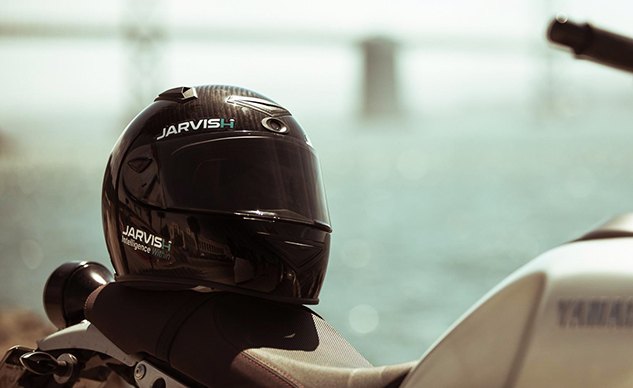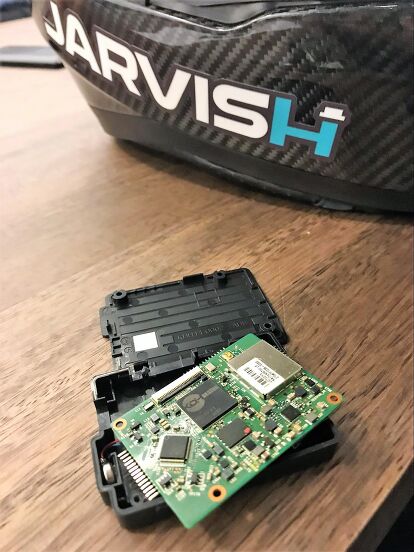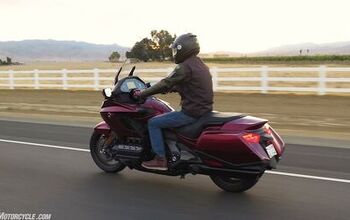Jarvish X and X-AR Helmets First Look
An iPhone for your head, or why you should care about smart helmets
What’s your helmet for? Primarily, it’s on your head to protect your head, and that technology hasn’t changed much since LBJ was yanking on the ears of his basset hounds. But it could do more, says Taiwan’s Jarvish Helmet. Much more.
Jarvish, a technology firm with roots in Taiwan’s high-tech industry, has introduced two motorcycle helmets with built-in electronics that connect the rider to the world around them with cameras, microphones, accelerometers, gyroscopes, and in the high-end X-AR model, an “augmented reality” heads-up display. What does that mean to you? It means you get an integrated package that works right out of the box – no need to buy, mount and set up various headsets and cameras – to record your ride, communicate with other passengers and riders, and give you directions and other information.
Why should you care? Well, let’s get in the way-back machine to 2007 so I can make a point. Are you in 2007? Listening to some Rihanna on the ol’ iPod, are you? Rockin’ your “Von Dutch” t-shirt? Good. Now dig in the pocket of your low-rise jeans. Odds are you have some kind of flip-phone or maybe a Blackberry in there. If I told you that you needed an Apple “iPhone” (whatever that’s supposed to be,) you would scoff. You’ve already got a phone, you would say. The first iPhone, released in June of that year, only had 500 apps; most of these were pretty freakin’ lame. Remember PhoneSaber? How about Rolando? Yeah, me neither. The iPhone was an okay phone, a fun toy and…what else?
A decade-plus later, and I spend a lot of time – too much time – on my iPhone. But I’m not playing Rolando or Angry Birds. I’m using it to make money via Uber, Lyft and AirBnB, I’m using it to schedule my daily activities, communicate with people I don’t like all over the world, use it for entertainment, education…it’s mind-boggling how useful it is.
And that’s what Jarvish wants to do for the helmet. They’re looking for “new use cases beyond basic conductivity,” according to Don Merino, Jarvish’s EVP for Business Development. The basic $799 Jarvish X has much of the stuff that’s in your smartphone; accelerometer, Bluetooth, cameras, microphone, speakers, battery, and an HD-capable camera, all connected to a compact processing unit. A 16GB memory card (expandable to 256GB) stores video for later.
Unlike your phone, it’s also a DOT/ECE-approved helmet, with a carbon-fiber shell, removable liner and other helmet-y features that all weigh in around 1500 grams, or 3 pounds, five ounces (which sounds about right). Combining a motorcycle helmet with smartphone tech opens a world of possibilities, possibilities we can only guess at today. Ten years from now, it could be as ubiquitous as the black devil’s oblong you may be reading this on right now.
So, who is Jarvish? The guys I met – VP for Business Development Don Merino, Co-Founder and CTO Younger Liang and Founder and CEO Jeremy Lu – told me Jarvish sprung from Foxconn’s Advance Technology Division team. It originally worked with AGV to develop a smart helmet; on completion of that helmet, Jarvish pivoted to make a product of its own. That it comes from Foxconn is key; that company, famously, makes the Apple iPhone. It’s unclear if Foxconn still owns Jarvish, but I believe it’s an independent startup.
Note these guys are not dorky college roommates with little business sense and what they think is a good idea, like a lot of tech startups. It’s a serious, professional effort. Already, 500 first-generation Jarvish helmets have been issued to Taipei police officers, and a total of 5,000 helmets are in use in Taiwan. Motorcycle cops can use the camera – which works in low-light conditions – for facial recognition, to read license plates, and instantly tell higher-ups where officers are on the map. But that’s just the start; “We expect users will demand and develop [applications] themselves,” said Merino. What kind of apps? Imagine being able to give voice commands to your motorcycle’s black box while you’re riding, or beam onboard video of a dangerous drunk to a 911 dispatcher, or patch into another rider’s camera to see what the pavement is like 6 turns ahead. I’d say the only limits are the imaginations of tens of millions of motorcyclists around the world.
Rounding out the lineup is the $2,599 AR (for “Augmented Reality”) model, which adds a rear-view camera and HUD (that’s a head-up display, in case you’re not an F-18 pilot or German-car owner). I tried the HUD in a static environment, and I can tell you it works (at least in demo mode), with a clear, bright image and quick response. The tiny screen, about the size of a quarter, retracts and deploys on command and is always at least 80% translucent. It displays all kinds of info: vehicle speed, directions, audio information, and even a real-time rear-view image. I can also tell you that it will take some getting used to if I don’t want to run into the back of a UPS truck in about 14 seconds, but we always lag behind technology, don’t we? I think with training and practice an HUD could be a net positive.
As for the helmet itself, it should be pretty solid. Jarvish is using an established and experienced Taiwanese manufacturer, which makes helmets for AGV, Lazer (branded as Klim in the U.S.) and Bell, among others. Putting it on revealed pretty standard build quality and features; nothing remarkable about the X-AR in that respect.
But wow, it’s expensive at $2,599, and there are good reasons for the plotz-inducing pricetag. The display screen is similar to the $2,295 dual-prism Magic Leap Augmented Reality system, the battery is military-grade and the entire system (X and AR) are water and dust-proof to the international IP57 standard, which means you can completely immerse the helmet for four hours and it will work after you dry it out.
You may wonder what happens to all that expensive hardware in a crash. It’s pretty tough stuff – Don told me the specs for the electronics are “two level higher” than what goes into smart phones – but if the helmet is damaged everything goes into the trash and you have to buy a new one. The battery – good for six hours in the X and 4 hours in the AR – is replaceable, though you have to return the helmet to a service center.
The good news is prices will come down with volume, and likely size as well. Right now Jarvish has to link two control modules together, but if they can order millions of units, they will be able to combine them into one, saving weight, complexity and cost. “We can go down to a pretty low-cost helmet,” said Don. Millions? Yep. A 2010 study estimated there are 83 motorcycles per 1000 people worldwide, and it’s probably significantly greater today. That’s 381 million motorcycles. Just in Asia. So, if we North American motorcyclists aren’t receptive, Jarvish won’t spend much time collectively weeping; we’re only about three percent of the world market. They seemed a bit lukewarm about this market. We’re older and not as interested in tech as riders in overseas markets. Half of us don’t even wear helmets.
I’m looking forward to testing the Jarvish, and you can expect a full review, hopefully before the X is available to crowdfunders this year and the X-AR early next year. Although a lot of the comments below will likely focus on the shocking, cost-of-a-good-used-motorcycle pricetag of the X-AR, I think the lid to watch will be the $799 (an iPhone XR is $749, and it’s not even a helmet).
Not only is the Jarvish X much lighter than a standard helmet with communications and video gear mounted to it, it is likely about the same price (a GoPro Hero7 is $200, a good headset is $150-200, and a nice helmet is $200-500, so that’s $550-900) and all (potentially) works seamlessly, thanks to proven Alexa technology. Seeing what kind of apps will follow this product make it even more interesting. Others have promised a smart helmet, it looks like Jarvish may be the first to bring it to mass market. Let’s see what happens.
More by Gabe Ets-Hokin










































Comments
Join the conversation
"Hey Siri, find the nearest gas station."
According to your profile, motorcycling is your passion.
"Hey Siri, find a GAS STATION."
According to wikipedia, mass starvation is a widespread scarcity of food...
"Hey Siri, ROUTE TO GAS STATION."
I don't see Gaston Statesman in your contacts.
"Goddamnit!...
Hey Siri, text Gabe and tell him to fµck off!"
Okay, message sent. Do you want to add something about his mother?
Hard hitting piece.. (It just made me barf..) .. Great Darwin Award enabling devices. How can be reality more augmented than by distractedly running a read light or riding into a tractor trailer?